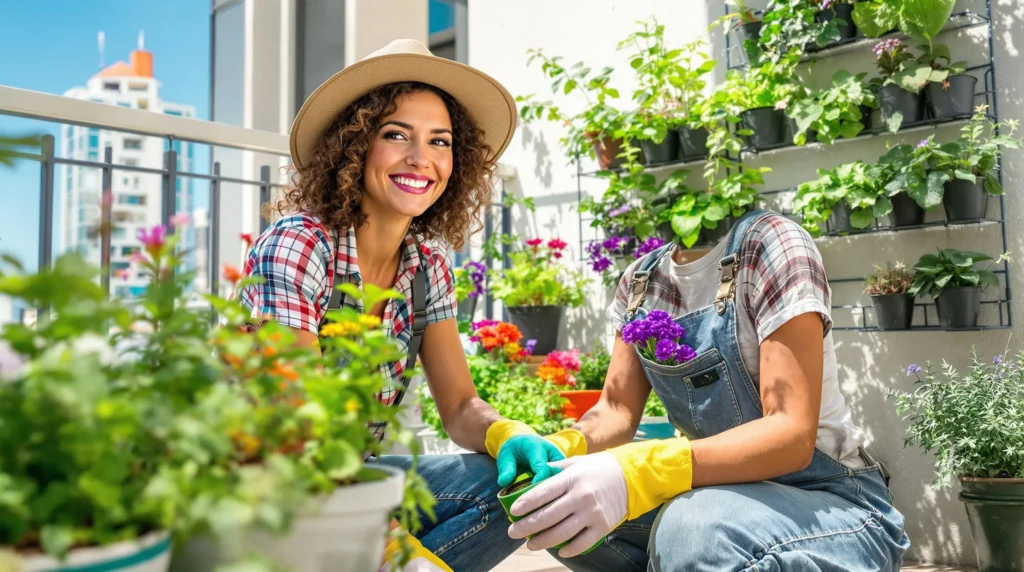10 Space-Saving Container Ideas for Small Organic Gardens
- Vertical Garden Planters – Maximize your growing space by going upward. Vertical planters attach to walls, fences, or balcony railings, letting you grow herbs, lettuce, and strawberries without sacrificing floor space. Install a pocket-style fabric planter or repurpose a shoe organizer for an instant garden that takes up minimal room.
- Hanging Baskets – Use overhead space with hanging baskets suspended from ceilings, pergolas, or shepherd’s hooks. These versatile containers work perfectly for trailing plants like cherry tomatoes, herbs, and nasturtiums. Select lightweight, organic potting mix to avoid strain on your hanging hardware.
- Window Boxes – Transform unused windowsills into productive growing spaces with narrow, rectangular planters. Window boxes provide excellent drainage and suit shallow-rooted crops like salad greens, radishes, and herbs. Mount them securely and ensure they receive adequate sunlight throughout the day.
- Stacking Planters – Cultivate multiple plants in a single footprint with tiered or stacking planters. These space-efficient systems create growing areas at different heights, ideal for mixing sun-loving plants on top with shade-tolerant varieties below. Look for options made from sustainable materials like recycled plastic or natural clay.
- Railing Planters – Convert balcony or deck railings into growing real estate with specially designed containers that hook over railings. These sturdy planters create an instant garden without taking up floor space, perfect for growing herbs, flowers, and compact vegetables like bush beans.
- Upcycled Containers – Repurpose household items like wooden crates, metal buckets, or even old drawers into unique planters. Drill drainage holes in the bottom, add organic soil, and plant compact varieties of your favorite vegetables. This approach reduces waste while adding character to your garden.
- Self-Watering Containers – Invest in planters with built-in reservoirs that supply water as plants need it. These containers reduce maintenance time, conserve water, and provide consistent moisture for thirsty crops like tomatoes and cucumbers. They’re especially valuable for busy gardeners or during hot weather.
- Fabric Grow Bags – Use lightweight, breathable fabric pots that prevent root circling and promote healthier plants. These portable containers can be placed anywhere with adequate sunlight and moved as needed. Their excellent drainage makes them ideal for root crops like carrots and potatoes.
- Gutter Gardens – Mount sections of vinyl gutters to walls or fences to create long, shallow planters perfect for growing lettuce, spinach, and other greens. This clever solution uses minimal space while providing ample growing area for shallow-rooted plants. Ensure proper drainage by drilling holes every few inches.
- Rolling Planter Carts – Place containers on wheeled platforms or purchase planters with built-in casters to create a mobile garden. This flexibility lets you chase the sun throughout the day or move plants to protected areas during harsh weather. Choose sturdy carts that support the weight of soil, plants, and water.
How to Build Vertical Organic Gardens in Limited Spaces
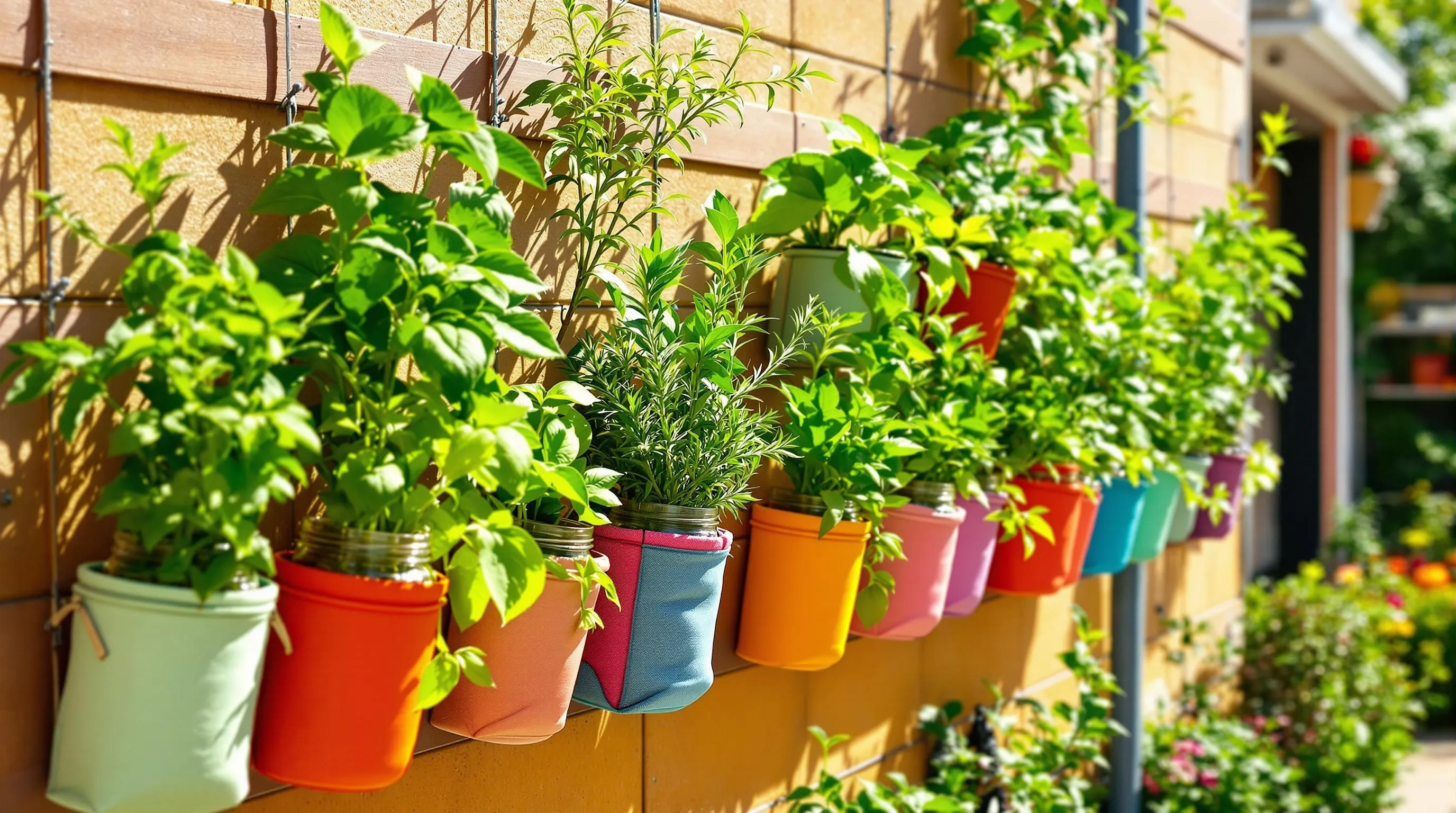
Vertical gardening maximizes your growing space by utilizing walls, fences, and other upright structures. This approach is perfect for urban dwellers or anyone with limited horizontal space who still wants to enjoy homegrown organic produce.
Wall-Mounted Herb Gardens
Creating a wall-mounted herb garden is surprisingly simple and immensely rewarding. Start by selecting a sunny wall space that receives at least 4-6 hours of direct sunlight daily. Choose containers with proper drainage, such as repurposed mason jars with drainage holes, fabric pocket organizers, or specialized wall planters. Attach them securely to your wall using appropriate hardware based on the surface type. Fill containers with organic potting mix enhanced with compost, then plant culinary herbs like basil, thyme, rosemary, mint, and cilantro. Position frequently used herbs at eye level for easy harvesting while cooking. Water carefully to prevent overflow, and fertilize monthly with organic liquid fertilizer to ensure healthy growth and abundant harvests.
Trellises and Living Walls
Trellises transform vertical spaces into productive growing areas for climbing plants like cucumbers, peas, and beans. Install a sturdy trellis against a wall or as a freestanding structure, ensuring it’s securely anchored to support the weight of mature plants and produce. For living walls, use modular systems with built-in irrigation or DIY options like pallets lined with industry fabric. Plant shallow-rooted crops like lettuce, strawberries, and compact herbs in the pockets or compartments. Position sun-loving plants at the top and shade-tolerant varieties at the bottom to match their light requirements. Water living walls more frequently than traditional gardens, as they tend to dry out faster. These vertical systems not only produce food but also add impressive visual interest to blank walls while improving air quality and providing natural insulation.
Square Foot Gardening: Maximizing Your Small Organic Plot
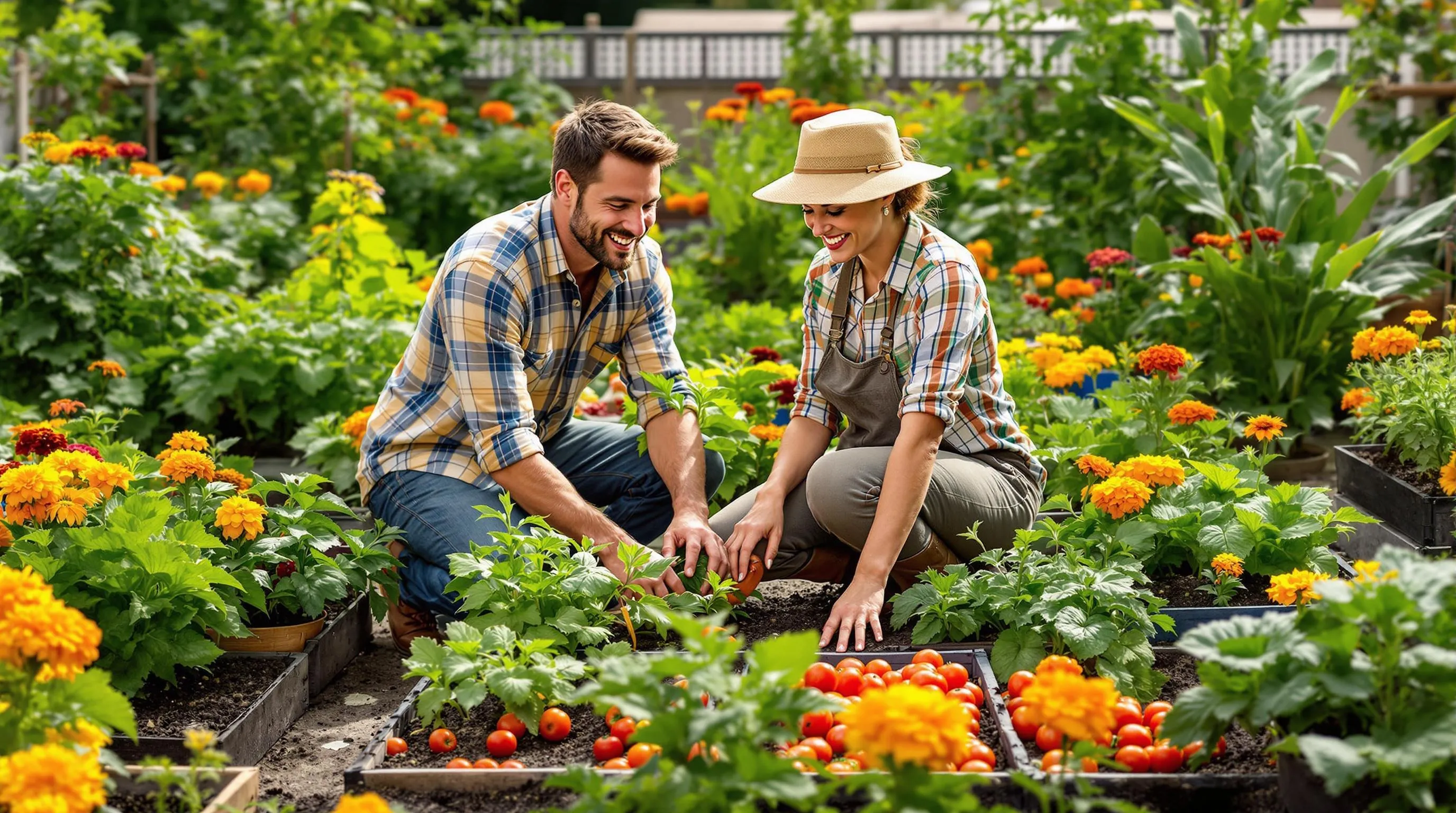
Square foot gardening revolutionizes how you approach small-space cultivation by dividing your plot into manageable 1ft × 1ft squares. This method allows you to grow significantly more food in less space while maintaining organic principles.
Grid Planning Techniques
Start your square foot garden by creating a physical grid using thin wood strips, string, or even bamboo stakes. Divide a 4ft × 4ft raised bed into 16 equal squares, with each designated for exact crops based on their spacing needs. Dense-growing plants like radishes accommodate 16 per square, while medium-sized vegetables like bush beans fit 9 plants per square. Larger vegetables like peppers need 4 per square, and space-intensive crops like broccoli require an entire square. Fill your grid with organic, nutrient-rich soil mix (⅓ compost, ⅓ peat moss, ⅓ vermiculite) instead of garden soil to maximize growth potential. Keep detailed records of what’s planted where, enabling efficient crop rotation and companion planting for future seasons.
Companion Planting in Square Foot Gardens
Leverage companion planting to boost your square foot garden’s productivity and pest resistance. Pair tomatoes with basil to improve flavor and repel flies and mosquitoes. Plant carrots alongside onions to deter carrot flies while onions benefit from the additional space. Interplant marigolds throughout your grid to naturally repel aphids, nematodes, and other harmful insects. Create mutually beneficial relationships by growing nitrogen-fixing plants like beans near nitrogen-hungry crops such as corn. Since space is limited, avoid combinations that compete for resources – never plant fennel near most vegetables as it inhibits growth. For successful square foot companion planting, research plant families and their compatibility before arranging your grid, and always consider mature plant size to prevent overcrowding that could lead to disease or reduced yields.
Creating Raised Beds for Small Organic Gardens
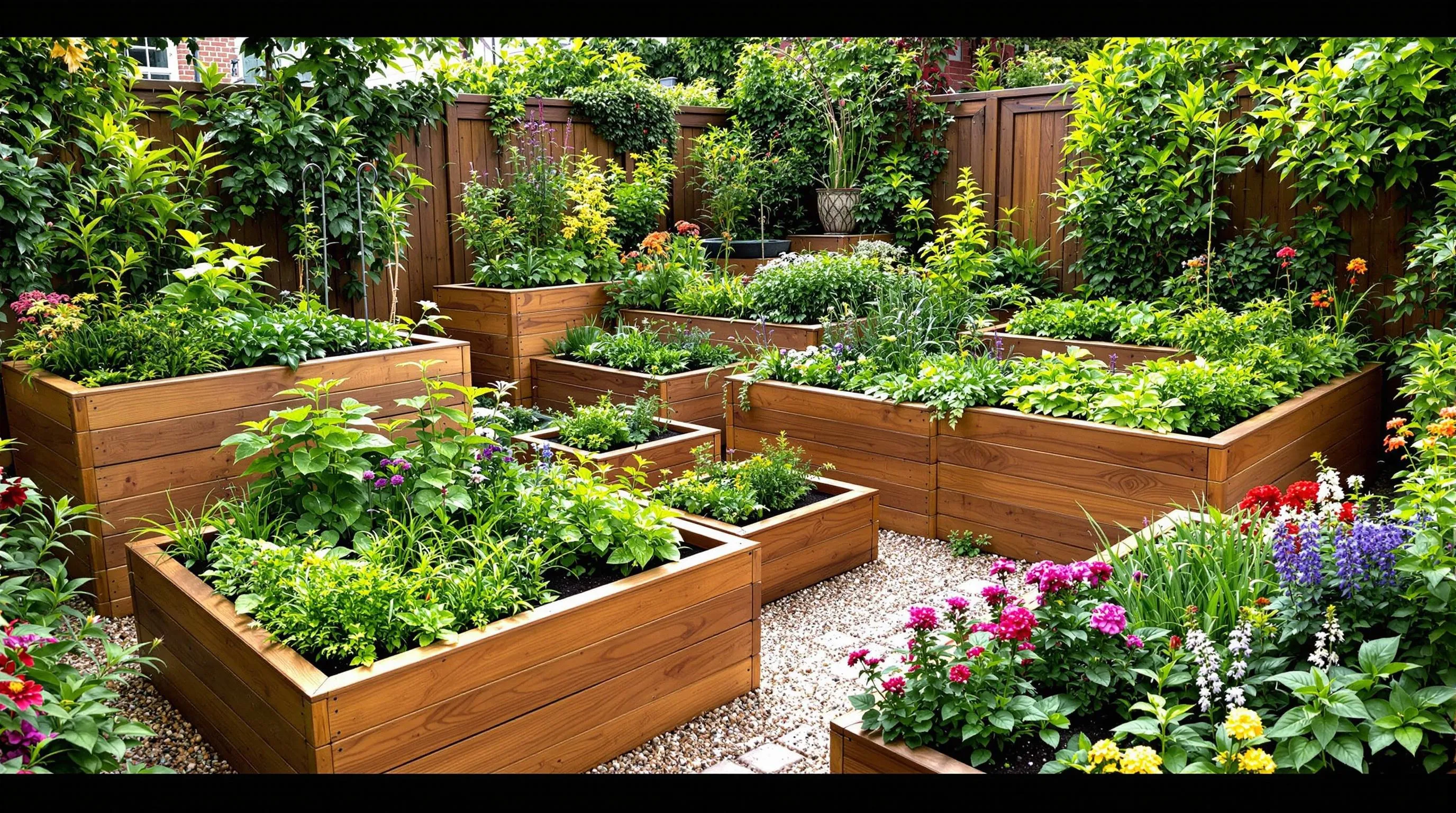
Raised beds offer an ideal solution for small-space organic gardening, combining improved soil control with efficient space utilization. These elevated growing areas allow you to maximize productivity in limited spaces while maintaining organic growing principles.
Space-Efficient Raised Bed Designs
Keyhole gardens serve as perfect space-savers, featuring a circular design with a notch for easy access to all plants without stepping on soil. Tiered raised beds create multiple growing levels within the same footprint, effectively tripling your growing space in areas as small as 4×4 feet. Consider narrow rectangular beds (3-4 feet wide) along fences or walls to use otherwise unused perimeter spaces. L-shaped corner beds maximize awkward spaces while creating visual interest in your garden. For ultra-small spaces, try pyramid-style raised beds that taper upward, providing different planting depths for various crops. Modular raised bed systems offer flexibility with interlocking pieces that can be arranged to fit unusual spaces and expanded as needed. These designs work particularly well in urban environments where every square inch matters.
Best Soil Mixtures for Organic Raised Beds
The ideal organic raised bed soil mixture follows the “⅓ rule” – combine ⅓ compost, ⅓ vermiculite or perlite, and ⅓ good-quality topsoil for optimal drainage and nutrition. Enhance this base with well-aged manure from herbivores (chicken, rabbit, or horse) to boost fertility naturally. Add mineral amendments like rock phosphate, greensand, or kelp meal to provide essential micronutrients without synthetic fertilizers. Incorporate worm castings (5-10% of total volume) to introduce beneficial microorganisms that improve soil structure and plant immunity. For acid-loving plants, mix in pine needles or coffee grounds, while crushed eggshells benefit calcium-hungry crops like tomatoes. Avoid using treated lumber for bed construction as chemicals can leach into your organic soil. Top your soil mixture with organic mulch like straw, shredded leaves, or grass clippings to retain moisture and suppress weeds, refreshing your soil annually with compost to maintain fertility.
Utilizing Windowsills and Balconies for Organic Micro-Gardens
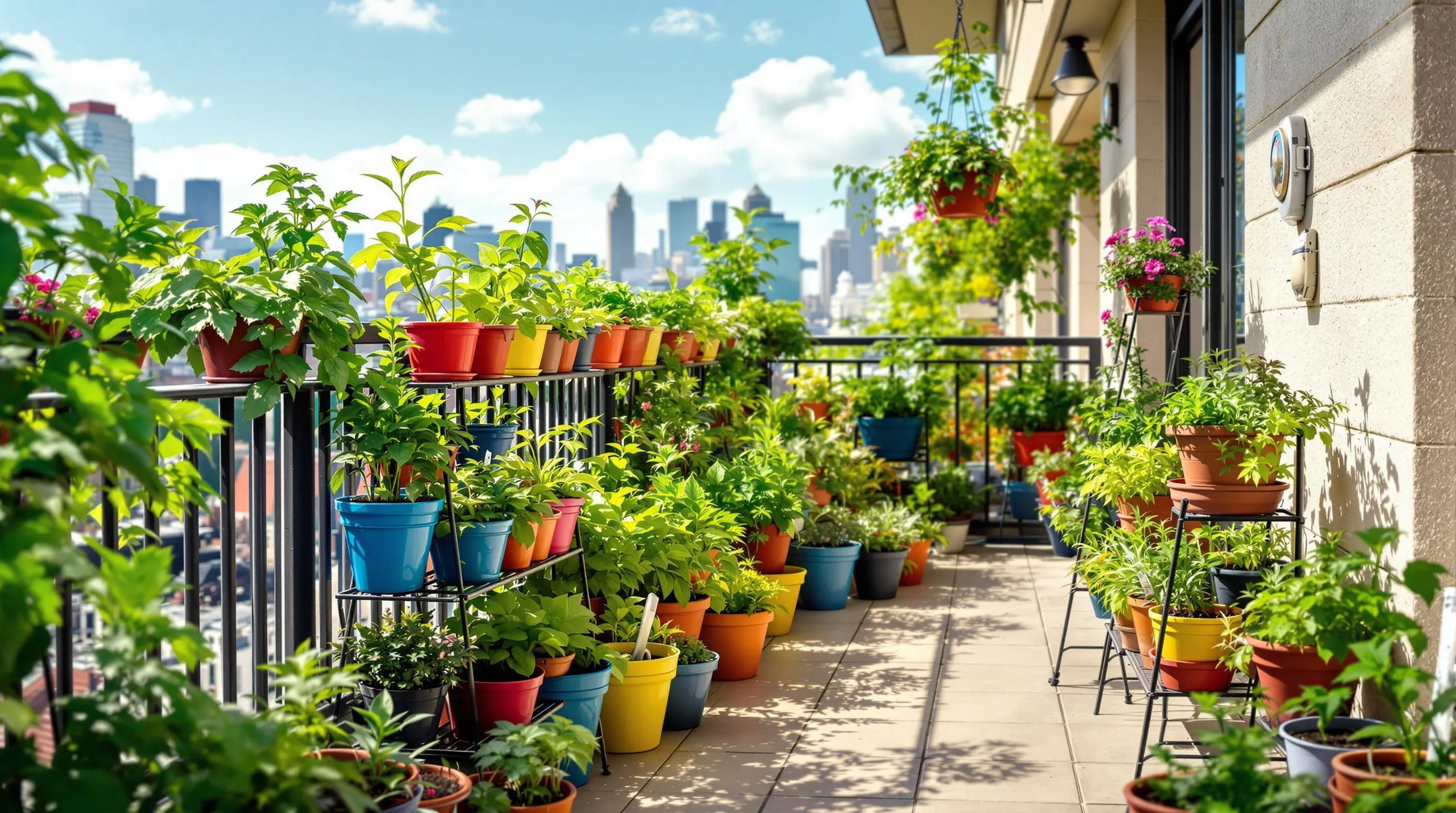
Even without a yard, you can create thriving organic gardens on windowsills and balconies. These micro-gardens maximize limited spaces while providing fresh herbs, vegetables, and flowers. Start by assessing your light conditions—most edible plants need at least 6 hours of sunlight daily. Choose shallow containers with drainage holes for windowsills, and larger pots for balconies that can support more weight. Opt for compact varieties like cherry tomatoes, lettuce, radishes, herbs, and dwarf peppers that grow well in containers. Create multi-level systems using tiered plant stands or hanging baskets to use vertical space. Install window boxes on the outside of your sills for additional growing area, securing them properly to prevent accidents. For balconies, use railing planters and corner shelving units to maximize every inch. Carry out water-saving techniques like self-watering containers or water reservoirs, as container plants dry out faster than in-ground ones. During extreme weather, protect your micro-garden with shade cloth in summer or bring plants indoors during frost. With thoughtful planning, even the smallest urban spaces can yield impressive organic harvests year-round.
Indoor Organic Gardening Solutions for Tiny Spaces
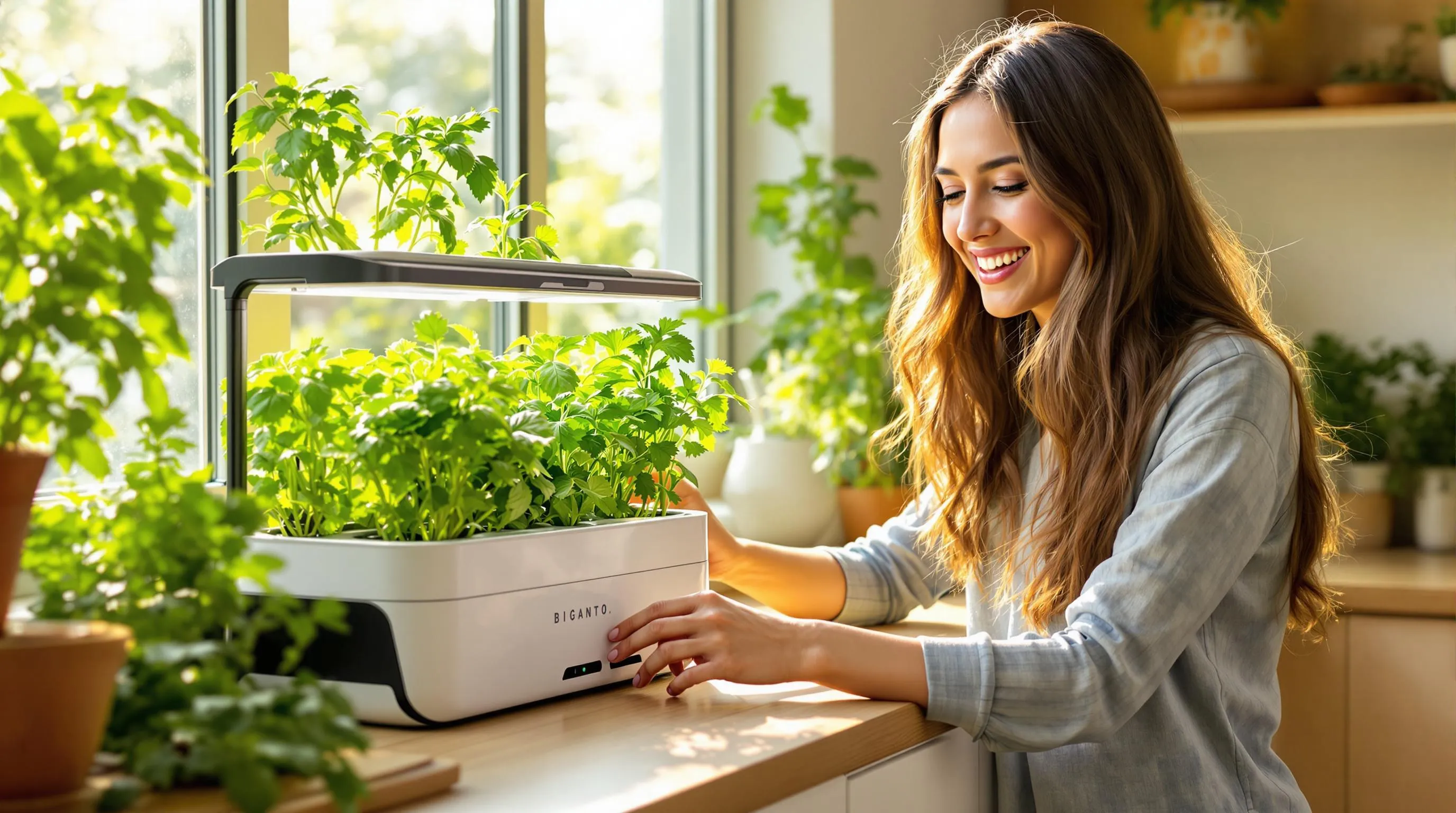
When outdoor space isn’t available, indoor organic gardening offers a practical alternative for growing fresh produce year-round. These space-efficient systems let you cultivate herbs, vegetables, and even some fruits without soil or sunshine.
Hydroponic and Aquaponic Systems
Hydroponic systems allow you to grow plants without soil, using nutrient-rich water answers instead. These compact setups require 90% less water than traditional gardening while producing yields up to 30% faster. Simple DIY hydroponic systems include the Kratky method using mason jars, water culture systems with air pumps, and nutrient film technique (NFT) setups using PVC pipes. For a more sustainable approach, aquaponic systems combine fish-keeping with plant cultivation, creating a symbiotic network where fish waste fertilizes plants while plants filter the water. Compact counter models like the Back to the Roots Water Garden fit easily in apartments, while small vertical systems can accommodate leafy greens, herbs, and compact vegetables like cherry tomatoes and peppers.
Countertop Herb Gardens
Countertop herb gardens bring fresh organic flavors directly to your kitchen with minimal space requirements. Self-contained systems like AeroGarden and Click & Grow provide built-in LED lighting and automated watering, making herb cultivation effortless even in windowless apartments. These systems typically accommodate 3-9 plants in spaces smaller than a microwave. For a budget-friendly alternative, arrange small terracotta pots on a sunny windowsill or install a wall-mounted magnetic planter system above your counter. Fast-growing herbs like basil, cilantro, chives, and mint thrive in these limited spaces and can be harvested continuously for months. Position your herb garden near your food preparation area for easy access while cooking, ensuring you’ll actually use what you grow.
Organic Pest Control Methods for Small Gardens
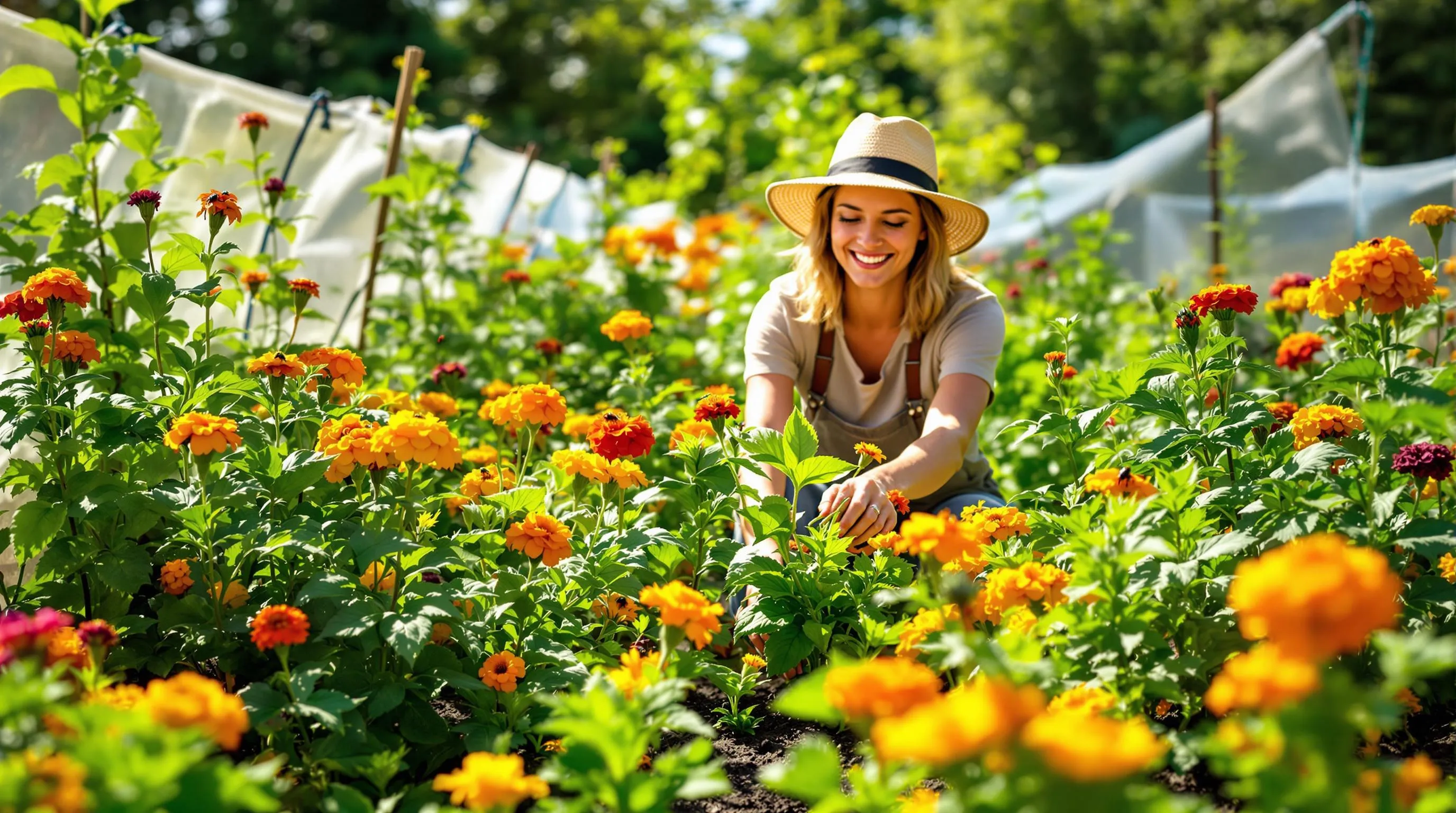
Maintaining pest-free organic gardens doesn’t require harsh chemicals. Start by implementing prevention strategies like companion planting, where marigolds repel nematodes and basil deters mosquitoes and flies. Build healthy soil with compost to strengthen plant immunity—plants grown in nutrient-rich soil naturally resist pests better. Install physical barriers such as row covers or netting to protect vulnerable crops from flying insects. For active infestations, try homemade insecticidal soap (1 tablespoon mild liquid soap per quart of water) to target soft-bodied pests like aphids and mites. Introduce beneficial insects like ladybugs and lacewings that naturally prey on garden pests. Diatomaceous earth creates an effective barrier against crawling insects when sprinkled around plants. Neem oil offers versatile protection against multiple pest species while remaining safe for beneficial insects when used correctly. Remember that small gardens actually have advantages in pest management—their contained nature makes manual removal of pests and regular monitoring much more manageable than in larger spaces.
Water-Saving Irrigation Systems for Sustainable Small Gardens
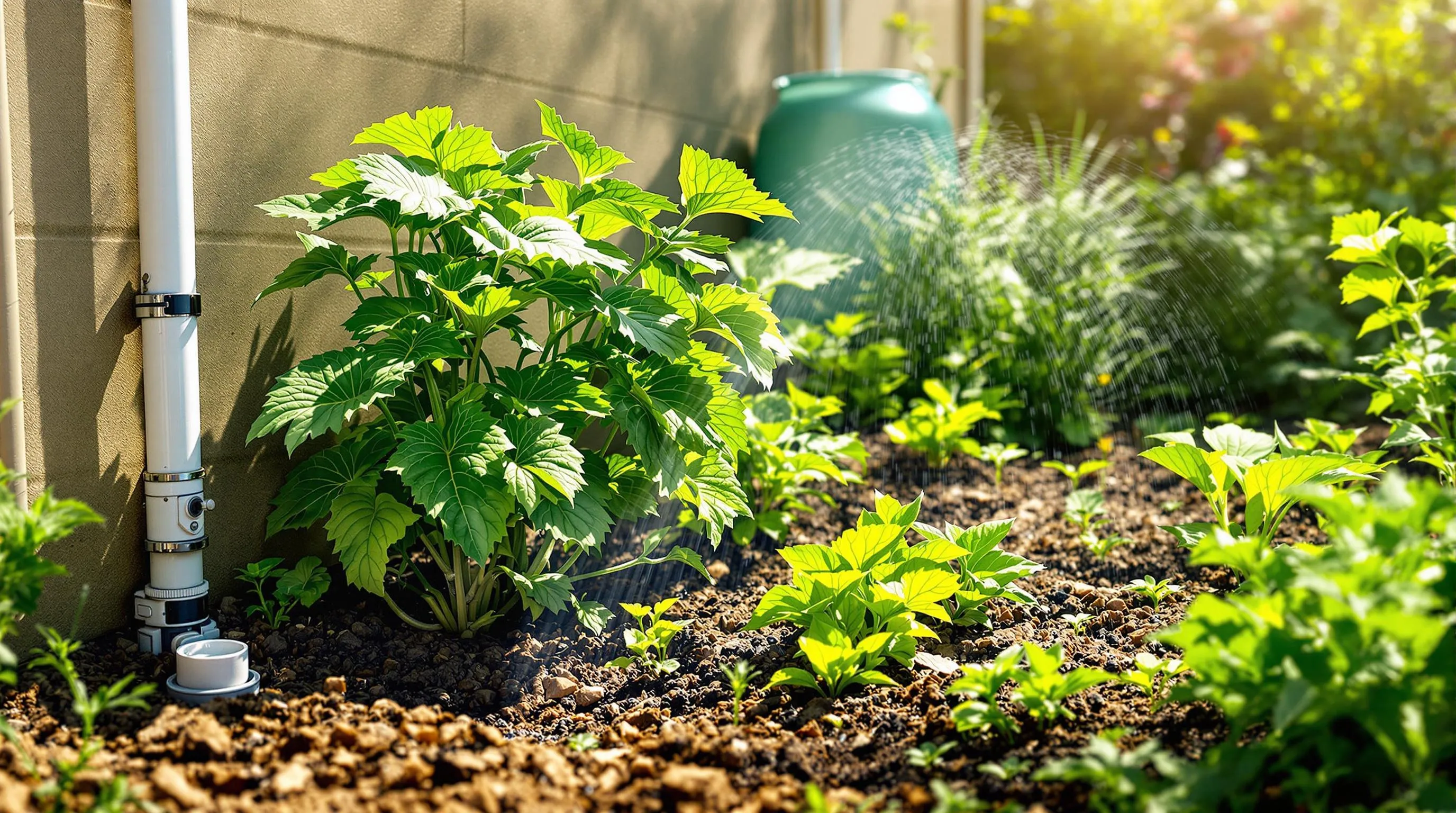
In small organic gardens, efficient water use is crucial for sustainability. Drip irrigation systems deliver water directly to plant roots, reducing waste by up to 60% compared to traditional sprinklers. Install a simple DIY drip system using perforated hoses or specialized drip tape connected to a timer for automated watering. Ollas—unglazed clay pots buried near plants—provide another ancient yet effective solution, slowly releasing water into the soil as needed. For container gardens, self-watering reservoirs eliminate runoff while cutting water usage by 30-50%. Rainwater harvesting systems, even compact ones like rain barrels attached to downspouts, can collect important amounts of water during rainy periods. Smart irrigation controllers that adjust watering schedules based on weather forecasts and soil moisture sensors further optimize water use. These water-saving answers not only conserve a precious resource but also promote healthier plant growth by maintaining consistent soil moisture levels without encouraging fungal diseases or weed growth.
Succession Planting to Maximize Organic Harvests in Small Areas
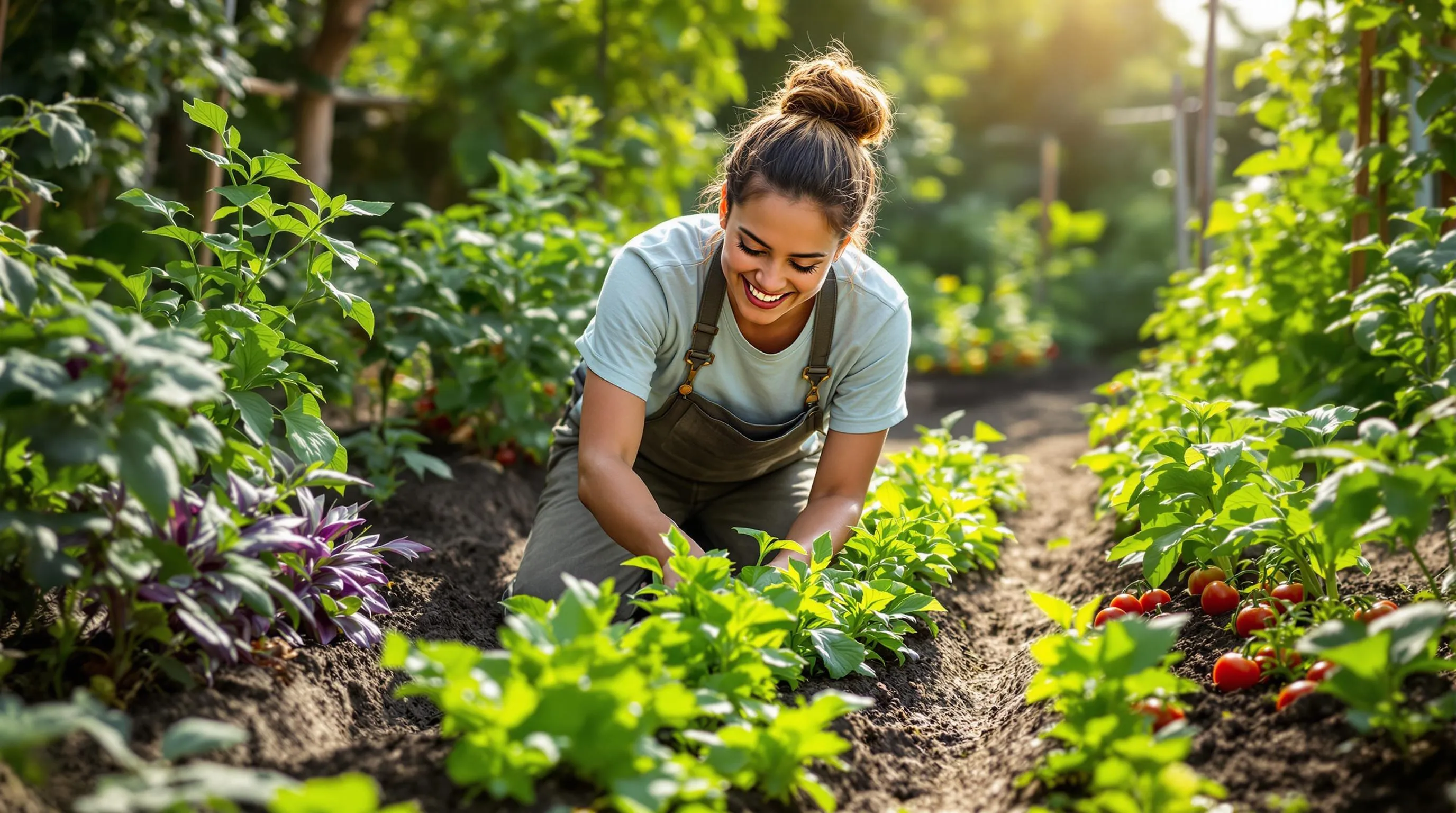
Succession planting is the secret weapon for small organic gardeners looking to multiply their yields without expanding their space. This technique involves planting crops in staggered time intervals to ensure continuous harvests throughout the growing season. Start by creating a detailed planting calendar that maps out when fast-growing crops like radishes, lettuce, and spinach can be harvested and replaced with new seedlings. Plant cool-season crops like peas and kale in early spring, then transition to warm-season varieties such as tomatoes and peppers as temperatures rise. Once summer crops finish, replant with fall vegetables like Brussels sprouts and carrots. Use interplanting to maximize every inch—tuck quick-growing green onions between slower-developing broccoli plants or plant shade-tolerant crops under taller ones. Keep a garden journal to track successful sequences and timing for your exact climate zone. With succession planting, even the smallest organic garden can produce 3-4 harvests from the same space, turning limited square footage into a continuous food production system that rivals much larger gardens.
Transforming Unusual Spaces: Creative Small Organic Garden Ideas
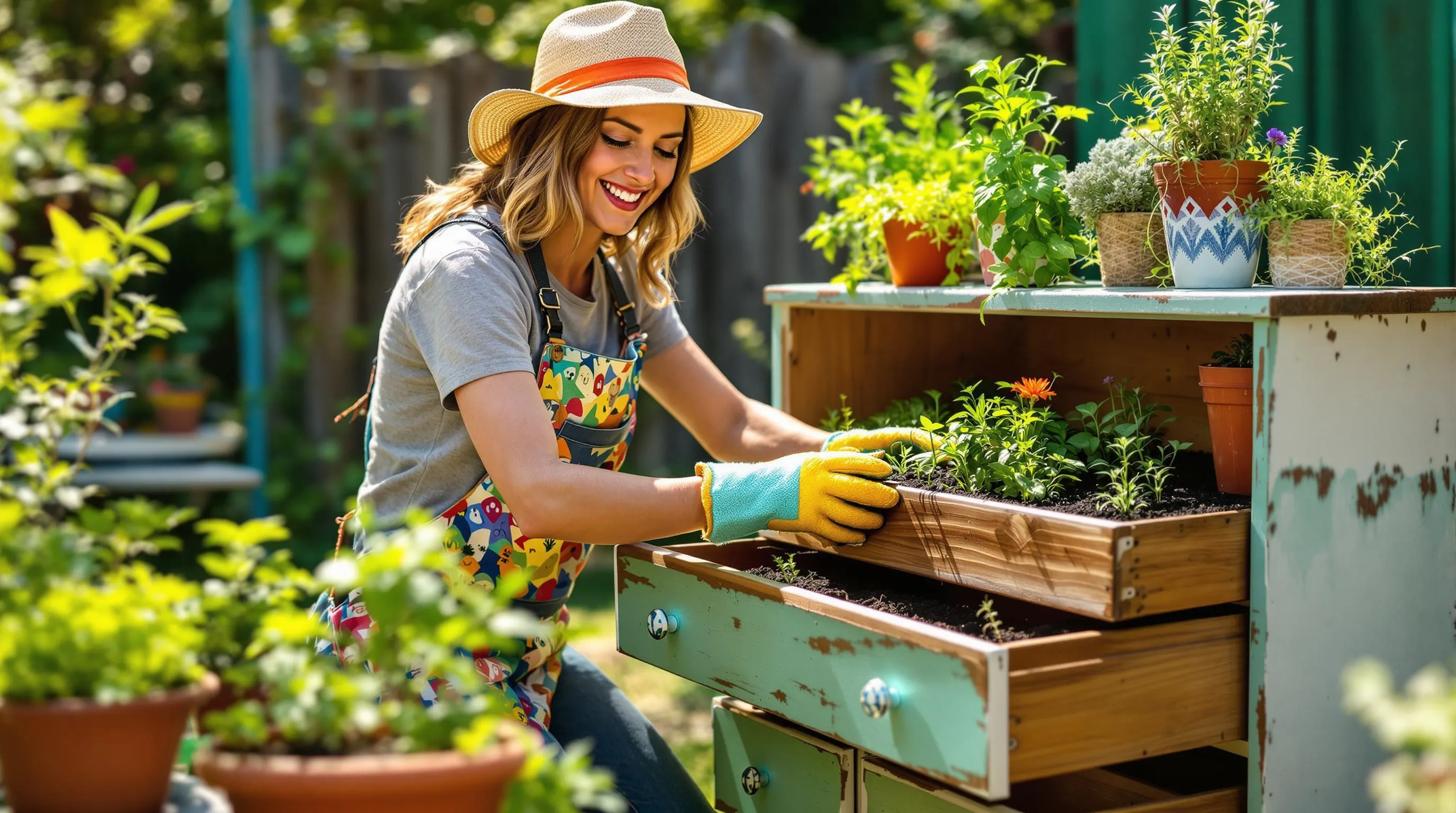
You don’t need a conventional garden plot to grow organic produce—unconventional spaces can be transformed into thriving growing areas with a little creativity. Old furniture pieces like dressers with open drawers make perfect tiered planters for herbs and shallow-rooted vegetables. Unused gutters can be mounted on sunny walls to create horizontal growing channels for lettuce and microgreens. Repurpose an old stepladder as a multi-level display stand for potted plants, maximizing vertical space while creating visual interest. Hollow stumps or logs can be transformed into natural planters for woodland herbs like mint and thyme. Even worn-out footwear can become quirky containers for small succulents or individual herb plants. The underutilized space beneath larger plants can host shade-loving crops like radishes or spinach in a technique called understory planting. By thinking beyond traditional garden beds, you’ll discover dozens of opportunities to grow organic food in spaces you might have overlooked, turning everyday items into productive growing environments while reducing waste through creative reuse.
Conclusion: Growing Big Flavors in Small Organic Spaces
Your small organic garden journey doesn’t require acres of land or years of expertise. With innovative answers like vertical gardens hanging baskets and space-efficient raised beds you can transform any limited space into a thriving network of fresh organic produce.
The beauty of small-scale organic gardening lies in its accessibility. Whether you’re utilizing windowsills aquaponic systems or creative upcycled containers you’re participating in a sustainable food movement right from your home.
Remember that successful small-space gardening comes from thoughtful planning efficient water use and natural pest management. By implementing the techniques shared here you’ll discover that even the tiniest gardens can yield impressive harvests while connecting you more deeply to the food on your plate.

